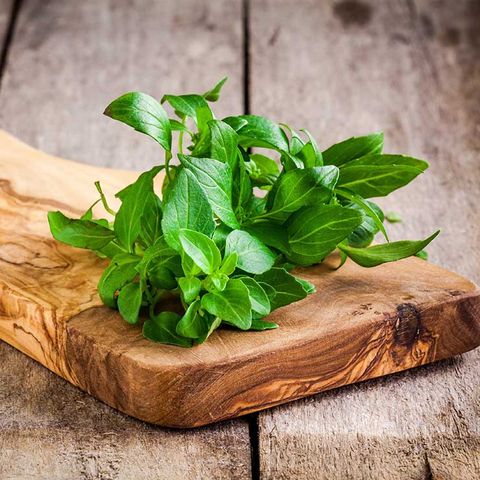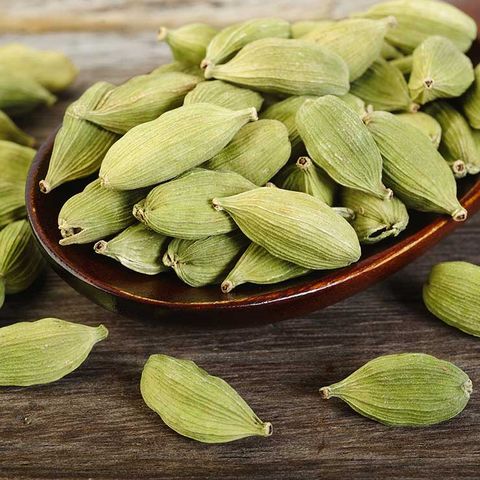Cooking With Herbs And Spices

natalya levish/shutterstock
1 of 16
There's simply no better way to add delicious, complex flavors to your meals—with essentially no extra calories, salt, sugar, or fat, mind you—than with spices. Plus, a growing body of research suggests that compounds found in many herbs and spices have potent health-promoting effects, from controlling blood sugar to ramping up metabolism.
Here, our top 15 nutrient-packed flavor-boosters to always keep on hand.

ekaterina kondratova/shutterstock
2 of 16
Basil
Warm, slightly spicy basil is packed with vitamins A and K. Its delicate leaves don't last long, though, so once you buy a bunch, whip up a quick pesto and toss it in the freezer to save for future dinners.

jeehyun/shutterstock
3 of 16

showcake/shutterstock
4 of 16
Cayenne
If you can handle the heat, season away: Cayenne pepper is rich in capsaicin, the compound responsible for spiciness, along with spicy foods' health benefits: Research shows capsaicin-rich peppers can boost metabolism and fat burn, increase feelings of fullness, and even help people eat fewer calories throughout the day. It's great with roasted nuts or veggies, sprinkled on scrambled eggs, stirred into soup or chili, or whisked into homemade salad dressing.

olha afanasieva/shutterstock
5 of 16
Cilantro
Some of us are genetically predisposed to despise the taste of cilantro; but if you're a fan, go crazy: It can help eliminate heavy metals like mercury from your body. It's a perfect compliment to Mexican dishes (like this shrimp and avocado salad), and it can also add a punch of bright, citrus-y flavor to smoothies, too.

Tetra Images/getty images
6 of 16
Cinnamon
Subtly sweet cinnamon is perfect with all your favorite breakfast items: Coffee, oatmeal, yogurt, baked goods, smoothies, pancakes...you get the idea. And it's been shown to blunt blood sugar spikes when you eat carb-heavy meals, keeping you even-keeled and minimizing cravings.

smdss/shutterstock
7 of 16
Cumin
Ground cumin adds rich smokiness to soups, chilis, tacos, and more. (It's also great sprinkled on yogurt.) Plus, one study found that eating just 1 teaspoon of cumin daily for 3 months caused people on a weight loss diet to lose 3 more pounds and 3 times as much body fat than people who didn't eat the spice. Researchers say cumin may be another spice that increases resting metabolism.

PhotoAlto/Laurence Mouton/getty images
8 of 16
Ginger
You already know that ginger can ease nausea. But the spicy root also has a few more tricks up its sleeve: It's been shown to reduce arthritis pain (it's got strong anti-inflammatory properties) and can even kill off H. pylori, a bacteria that can cause stomach ulcers. Get more by trying out these 5 ginger-infused recipes.

Banar Fil Ardhi / EyeEm/getty images
9 of 16
Garlic
Studies show that garlic can help your body fight off colds and even prevent buildup of plaque in your arteries. Repelling vampires is just a bonus. (Note: Go for whole cloves instead of powder if you can. The fresh stuff has more vitamins and nutrients.)

alena haurylik/shutterstock
10 of 16
Mint
Peppermint is the ideal fix when you go overboard on food and you're feeling bloated—it relaxes the muscles of the stomach and digestive tract, speeding digestion and the passing of gas. Research has even shown that it can improve symptoms of irritable bowel syndrome. Mint is perfect for light soups, smoothies, and summery salads; or just for steeping in a cup of your favorite tea.

Dionisvera/Shutterstock
11 of 16
Oregano
Your beloved pizza topper could also be a disease fighter: Test tube studies have confirmed its antimicrobial powers against bugs like MRSA, norovirus, and Listeria. Let its peppery flavor shine in this simple salmon pasta dish.

Riou/getty images
12 of 16
Parsley
Just 2 tablespoons of chopped parsley provide 140% of your daily vitamin K. Preliminary research also suggests that an antioxidant abundant in the herb could strengthen connections between neurons, potentially helping improve brain cell communication and ward off depression and Alzheimer's. It's perfect for garnishing just about anything, of course, but you can bump up your intake even further with recipes like this easy whole grain tabbouleh salad.

natalia klenova/shutterstock
13 of 16
Rosemary
Antioxidant-rich rosemary makes for insanely tasty roast chicken—and studies show it can neutralize carcinogenic compounds that form when certain foods (like bread and meat) are cooked at high temperatures.

Westend61/getty images
14 of 16
Sage
This herb is crazy versatile: You can add it to everything from baked oatmeal to polenta to meatloaf. Plus, two human trials found that sage extract improved participants' memory for hours at a time—researchers say it could work by acting on enzymes critical to brain function.

PhotoAlto/Laurence Mouton/getty images
15 of 16
Thyme
Eat just 2 teaspoons of dried thyme and you'll get 20% of your daily value of iron. Thyme's also long been used as a remedy for respiratory infections; try this easy recipe for thyme tea to make a soothing tonic at home. Its mildly minty flavor is also a perfect complement to richer, meat-based dishes like this beef noodle soup and this pan-roasted chicken with mushroom gravy.

Brian Yarvin/getty images
16 of 16
Turmeric
Turmeric is the most talked-about spice when it comes to health benefits, and it's all thanks to curcumin, a potent anti-inflammatory compound found in the spice. Curcumin has been studied for its potential to combat Alzheimer's, diabetes, arthritis pain, PMS pain, depression, and more. One of the easiest ways to take in more turmeric is in smoothies (we love this one), but it's also great on roasted veggies, in soups, and in traditional Indian fare.
Cooking With Herbs And Spices
Source: https://www.prevention.com/food-nutrition/healthy-eating/g20465948/15-herbs-and-spices-every-kitchen-should-have/
Posted by: smithsursee.blogspot.com

0 Response to "Cooking With Herbs And Spices"
Post a Comment